
|

| |
||||||
Eadweard Muybridge's Primitive Motion Studies (from 1884-1887) - The Human Figure in Motion - Descending Stairs and Turning Around Muybridge's test footage included cinematic glimpses of naked men and women in motion, such as in this sampling of pictures (to the right). |
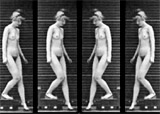  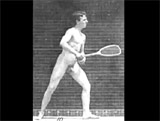 Motion Studies |
|||||

|
Carmencita (1894) Spanish dancer Carmencita was allegedly the first woman to appear in front of an Edison motion picture camera, and quite possibly the first female to appear in a US motion picture. The short film (about 21 seconds long) was directed and produced by Edison's employee William K.L. Dickson. She was filmed March 10-16, 1894 in Edison's Black Maria studio in West Orange, NJ. In some cases, the projection of the scandalous film on a Kinetoscope was forbidden, because it revealed Carmencita's legs and undergarments as she twirled and danced. This was one of the earliest cases of censorship in the moving picture industry. |
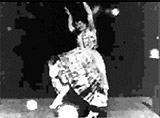 Carmencita |
||||
Le Coucher de la Marie (1896, Fr.) (aka Bedtime for the Bride, or The Bridegroom's Dilemma) "Blue movie" pornographer Eugene Pirou reportedly pioneered the risque film with the premiere of this film in Paris. He was responsible for producing this film (and other similar "smoking concert" or stag party films). The short film (only 2 minutes of which survives today of the original 7 minutes) was directed by Léar (real name Albert Kirchner). In this one, cabaret performer Louise Willy recreated a striptease from her cabaret act - the first striptease onscreen, although she was undressing behind a screen shielding her from the eyes of a gentleman (who was waiting and pretending to read a newspaper). In the surviving portion of the film, she was only down to her petticoat when the excerpt ended. |
 Undressing Behind Screen |
|||||
This short nickelodeon kinetoscope/film of a gyrating belly dancer named Fatima Djemille (well-known for her dancing shows at Chicago's Columbia World Exhibition in 1893) became one of the earliest films in which a scene was censored - for her gyrating and moving pelvis. It was covered up by what appeared to be a white picket fence (a grid-like pattern of white lines - see second image). At the time, there were numerous risque films that featured exotic dancers. |
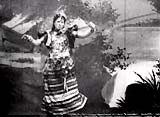 Uncensored Dance 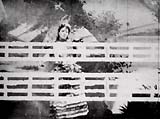 Censored |
|||||
The very first kiss on film was between a Victorian couple, seen in this Edison kinetoscope in a filmed scene enacted from the Broadway stage play The Widow Jones. It was a titillating short 20-second film loop, with a close-up of a nuzzling couple followed by a short peck on the lips ("the mysteries of the kiss revealed"). The kissing scene was denounced as shocking and pornographic to early moviegoers and caused the Roman Catholic Church to call for censorship and moral reform - because kissing in public at the time could lead to prosecution. |
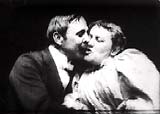 The Kiss |
|||||
Après Le Bal (1897, Fr.) (After the Ball, Bath) Pioneering film-maker Georges Melies directed this short, B/W silent film, which contained one of the earliest nude scenes in film history. In the scene, a fully-dressed person was helped to undress by a maid for a bath. |
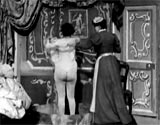 Undressing For a Bath |
|||||
Annabelle (Whitford) Moore's Dance Routines (mid-1890s) Many of the earliest nickelodeon films featured the dancing of vaudeville performer Annabelle Whitford (known as Peerless Annabelle), whose routines were filmed at Edison's studio in NJ:
Male audiences were enthralled watching these early depictions of a clothed female dancer (sometimes color-tinted) on a Kinetoscope (an early peep-show device for projecting short films). |
 
Annabelle Dance |
|||||
The Birth of the Pearl (1901) Proprietors of the arcade parlors and nickelodeons with hand-cranked kinetoscopes, designed to provide cheap entertainment for poor, lower-class immigrants in the cities, realized that sex (or erotica) sold. One example was this short provocative American Mutoscope & Biograph film about the 'birth of a pearl' in an art tableau. When the curtains were drawn to the side by two clothed chorus girls, a large oyster or clam shell was revealed in front of a painted backdrop of the ocean. As the shell opened, a sleeping or slumbering long-haired young model (wearing a flesh-colored body stocking) was curled up, but then slowly awakened from slumber and stood up. |
 "The Birth of a Pearl" |
|||||
From Show Girl to Burlesque Queen (1903) This titillating short film (one-minute in length) from American Mutoscope & Biograph was designed to stimulate its audience. It presented a view of a woman in her dressing room mischievously undressing and smiling at the camera - but after removing clothing and standing in a long white undergarment (and slipping the strap of her garment off one shoulder), she ducked behind a screen to her right. There, she continued to undress and furtively reach for other clothes. She then appeared costumed in another outfit. |
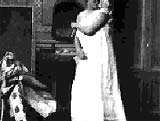 Dressing Room |
|||||
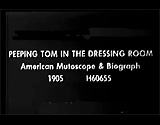
|
Peeping Tom in the Dressing Room (1905) This voyeuristic short was sexually enticing to early male audiences. A similar earlier title (not to be confused with) was Biograph's Peeping Tom (1897), in which a man spied through a keyhole on a busty female trying on a corset. In the 1905 short, a man was in an adjoining dressing room when through the thin wall, he heard two other females in a nearby dressing room. He watched in amazement as one of the females adjusted her garter under her long skirt. The man was caught spying by two other men who entered the dressing room and saw that he was 'peeping' through the wall. The humiliated 'peeper' was brought into the women's dressing room, where one of the two chorus girls beat him with powder puffs in the face. |
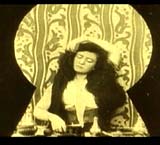 Peeping Tom (1897) |
||||
A L'Ecu d'Or ou la Bonne Auberge (1908, Fr.) This French film has been widely regarded as the oldest-surviving hard-core pornographic film. Early pornographic films were frequently displayed at brothels, and seized (and thereafter destroyed) when police raided the illegal establishments. The film's action was straightforward - a woman was seen pleasuring herself with a dildo, then another man and woman joined her for a threesome, involving lots of oral sex before intercourse. |
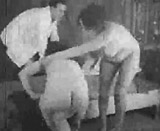 Oldest-Surviving Porn Film ? |
|||||
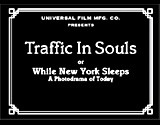
|
Traffic in Souls (1913) Carl Laemmle's newly-formed Independent Motion Picture Company's (IMP) first feature-length film release was the six-reel melodrama (and faux documentary) Traffic in Souls (1913) (aka While New York Sleeps). It was the most expensive feature film of its time at $57,000, although its record earnings were $450,000 during its first run. It was the first American feature-length sex film. This was one of the first films to understand that 'sex sells,' although its producers worried that a 'feature-length' film on any subject wouldn't be successful. It was a "photo-drama" expose of white slavery (entrapment and stalking of two young emigrant women into prostitution at brothels, called "dens of iniquity") at the turn of the century in NYC, although the film exploitatively promised steamy sex in its advertisements. |
 White Slavery Exposed in Traffic in Souls (1913) |
||||

|
Damaged Goods (1914) This early, dramatic sex-hygiene (venereal disease) educational film (now presumed lost) was typical of an early exploitation film with sensational content told with an educational slant. It was advertised as:
It was a smash-hit at the box-office when re-released in 1915 by the Mutual Film Corporation, with $2 million box-office revenue, and it caused a wave of similar exploitational films about the scourge of venereal disease for the rest of the decade.
There were three remakes:
In the original 1914 film, the plot was about how young lawyer George Dupont (Richard Bennett), a law school graduate, contracted syphilis from a prostitute or Girl of the Streets (Adrienne Morrison, Mrs. Bennett in real-life). Dupont contemplated drinking poison, but was dissuaded by the prostitute. Dupont was advised to seek VD treatment by specialist Dr. Clifford (Louis Bennison) and to not marry his fiancee Henriette Locke (Olive Templeton), the daughter of Senator Locke (John Steppling). He went against the doctor's advice, went to a quack doctor (William Bertram) for a quick cure, married Henriette, and then had a child that was diagnosed with syphilis. By film's end, Dupont committed suicide by drowning himself - walking into the sea (although in the re-release in 1915, the suicide was toned down to just the act of contemplating suicide). |
|
||||
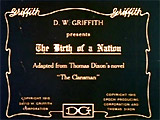
|
D.W. Griffith's Civil War epic The Birth of a Nation (1915) was controversial for many reasons, one of which was its racist and "vicious" portrayal of blacks and its proclamation of miscegenation (racial mixing), according to the NAACP. For that reason, it was the subject of bans for inciting "race hatred and race riots." In one long suspenseful scene, an emancipated former house servant/slave - an inflamed, lusty Negro "renegade" named Gus (Walter Long), chased after young Flora Cameron (Mae Marsh). Although he reassured her: "Wait, missie, I won't hurt yeh," she fell from a cliff after repeatedly threatening him -- "Stay away or I'll jump." The scene has often been misinterpreted as a rape scene, although it wasn't. However, it could be interpreted that her threatened state symbolized the emasculation and 'rape' of whites in the South by a rampant black population suddenly emancipated - and destructive of the racial order. In another controversial scene, lecherous mulatto leader Silas Lynch (George Siegmann, a white actor dressed as black and acting monstrously) attacked Elsie Stoneman (Lillian Gish), representing innocence, purity and virtue. He attempted to force marriage upon her. |
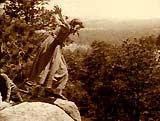 Flora's Jump to Death  Silas Lynch with Elsie Stoneman |
||||
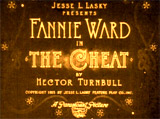
|
The Cheat (1915) Director Cecil B. DeMille's sensational melodrama combined elements of sexuality with sadomasochism, luring large audiences to theatres to watch it. It was an early example of DeMille's predilection for sensationalism and boldness in pushing the censors to the limit. The masterfully-filmed story was about an indebted married, spendthrift woman named Edith Hardy (Fannie Ward in her debut film) who turned to a benefactor, a wealthy Japanese/Burmese ivory merchant/dealer named Hishuru Tori/Haka Arakau (Sessue Hayakawa). When she was wanting to repay a loan of $10,000, he demanded her as repayment.
When she refused (in a 'rape' scene), the sexually-predatory, sadistic Asian man grabbed her by the hair, and branded her with a red-hot iron on her bare left shoulder, making her his property or possession. |
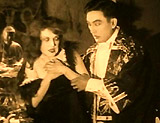 Edith with Benefactor  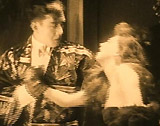 The "Rape-Branding" Scene |
||||
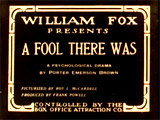
|
A Fool There Was (1915) The full-bosomed Theda Bara became an overnight sensation after her appearance in this melodrama. She was dubbed the "Vamp," and became the screen's first femme fatale (the first dangerous female in the movies) and first movie sex goddess or sex symbol.
The sexy actress was first introduced as an evil temptress in this film with her character name: Vampire. She was portrayed as a predatory vamp (luring men to ruin and destruction). The vamp was a reflection of the society's anxious fear and attraction to the newly-emancipated woman of the early 1900s. As a homewrecker, she destroyed the marriage of wealthy lawyer and statesman John Schuyler, a successful Presidential special envoy to Britain. She delivered her most famous lines to him, shown in two title cards, as she draped her arms over him:
|
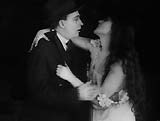  "Kiss me, my Fool!" |
||||
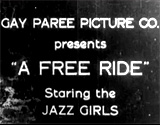
|
A Free Ride (1915) A Free Ride was reportedly the earliest-known US silent stag ('men only') or pornographic film. Because these kinds of films (with increasingly explicit amounts of nudity and sexuality) were completely illegal, they were shown in all-male locations, clubs, etc., not in mainstream theaters. Its comic titles foretold its plot:
It included explicit sex scenes of a wealthy man having sex with two female hitchhikers by the side of the road. |
  Excerpts From Stag Film |
||||
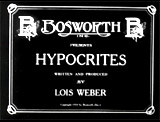
|
Hypocrites (1915) Hypocrites was a Paramount 4-reel silent film from female director Lois Weber - the most important and prolific of all American women directors of the silent era. It was the first American motion picture with a central role played entirely in the nude. The message film was considered a shocking and controversial film that was held up for many months because of its full nudity. Nudity was portrayed in the ghostly apparition or figure of the Naked Truth (innovatively super-imposed through double-exposure), literally shown by a nude woman (Margaret Edwards), who in the opening sequence, entered into the Gates of Truth. The nude, semi-transparent female revealed hypocritical desires for money, sex, and power in various vignettes (regarding politics, society, and the family). She guided the minister in monk's garb (now representing Gabriel the Ascetic (Courtenay Foote)) to teach him about hypocrisy (following his delivery of a sermon on the subject), as he tried to teach others about the Truth. In the end, the "prominent minister" expired in church during his Truth dream, shocking his congregation.
|
 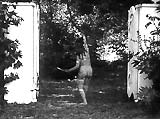 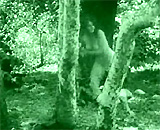
The Naked Truth (Margaret Edwards) |
||||
Inspiration (1915) (aka The Perfect Model)
This was the first known US film in which a named, leading actress (Audrey Munson) stripped down to be naked, making her the first nude film star. Her nude appearances were as a tableau vivant (silent and motionless) - with only her breasts and backside in view, In the film Inspiration, Audrey Munson (a world-famous, real-life 'perfect' art model for numerous Beaux-Arts sculptors) appeared artistically nude as a sculptor's model, recreating classic artistic (nude) paintings in George Foster Platt's controversial film from the Mutual Film Corporation. In fact, the film told the story of her own life. It was the first of Munson's four silent films. Munson also appeared nude in Purity (1916) (see below), The Girl O' Dreams (1918), and in Heedless Moths (1921). |

Audrey Munson - Model 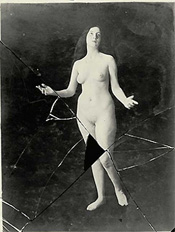 |
|||||

|
Behind the Screen (1916) In this two-reeler for Mutual, Charlie Chaplin portrayed a hired worker named David at a film studio. In the film's infamous 'gay' scene, he kissed a young girl (Edna Purviance) who was dressed in masculine clothing (as a masquerading way to find work), thereby upsetting his brutish and burly foreman Goliath (Eric Campbell). The boss believed they were homosexual and teased them mercilessly by acting 'prissy' to mock them. |
 "Gay" Scene |
||||
Daughter of the Gods (1916) This controversial film (filmed in Jamaica) starred Australian-born swimming and diving champ Annette Kellermann (the "Esther Williams of the silent era"). It was Kellermann's second feature film, and also the most expensive film of its decade at over $1 million. It was the first feature film to cost over a million dollars. In 1910, she had already gained attention for advocating the scandalous-at-the-time one-piece bathing suit, for which she was arrested in Boston Harbor. She was one of the first major female stars to appear nude on screen (although her body was often covered by her long hair). She was called "the world's most perfectly-formed woman" and "The Australian Mermaid," and billed as "the Diving Venus."
The only surviving elements of the film were those of Kellermann's nude scene. She caused a great stir when at the time, publicity posters displayed her naked, with her long flowing hair covering her breasts and pubic region. |
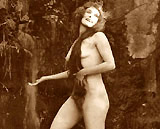  Publicity Stills of Annette Kellermann |
|||||

|
D. W. Griffith's lurid epic Intolerance (1916) featured bare-breasted, lightly-draped women ("virgins of the sacred fires of life") in love temples, in the tinted Babylonian sequences.
|
  Bare-Breasted Babylonian Love Temple Females |
||||
Purity (1916) After her appearance a year earlier in Inspiration (1915) (see above), sculptor's model Audrey Munson also appeared nude in another silent film, Rea Burger's 7-reel Purity (1916), in a dual role, as a spirit figure and as an artist's nude model named Purity/Virtue. The National Board of Review allowed nudity in the film, as long as it was shot at a distance and posed motionless (or viewed only momentarily). Even with some censored (or edited) scenes, the film was banned in various places (Kansas, and in the cities of Dallas and Washington). The New York Times called the film "offensive," claiming that Munson as Purity was a "beautiful figure of a famous model exploited on the screen." |
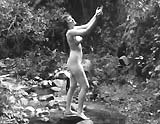
Audrey Munson as Purity/Virtue |
|||||
The Vixen (1916) (aka The Love Pirate) In this lost film, Theda Bara took the role of spoiled, deceiving nymphomaniac "vixen" Elsie Drummond. She wooed Wall Street businessman Martin Stevens (A. H. Van Buren) away from his interest in her sweet sister Helen (Mary G. Martin). She continued to seek after rich men, eventually marrying young statesman Knowles Murray (Herbert Heyes) (again stolen from Helen) - but still willing to be unfaithful with Stevens who had since regained his fortune. |
||||||
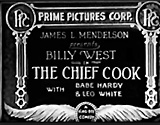
|
The Chief Cook (1917) In this Billy West (a Charlie Chaplin imitator) short silent comedy, Oliver Hardy appeared as Babe, the head of a touring theatre boarding house who inevitably caused trouble for West. The slapstick two-reeler contained a brief sequence in which the Star Boarder (Billy West) voyeuristically spied through a keyhole upon a young woman named Dolly (blonde starlet Ellen Burford) taking a bath and allowing a nude glimpse. [Note: Most prints of the film excised the sequence.] |
 
Bath Peeping-Tom Scene |
||||
Cleopatra (1917) This elaborately-produced film (now presumed lost) from the Fox Film Corporation was one of vamp Theda Bara's biggest hits. It was the sexy star's first film made in studios on the West Coast, and her most famous film - although only fragments exist today. When the film was promoted, publicists realized that her name Theda Bara was an anagram for "Arab Death." The fact was overly exaggerated with the claim that she was the reincarnated daughter of Seti, high priest of the pharaohs, and in a past life was actually Cleopatra. In the over two-hour long epic, she portrayed the historical Queen of Egypt Cleopatra -- noted for her risque and bare-breasted costuming. She was seen nearly nude with the contours of her breasts held by two curving gold asps, and she wore a gown with spidery embroidery over her crotch.
|
  Publicity Stills of Theda Bara |
|||||
Mack Sennett's "Bathing Beauties" Comedy pioneer and "King of Comedy" Mack Sennett popularized his sexually-appealing "bathing beauties" starlets. The swimsuited beauties were usually uncredited swimsuit models, although some became famous leading ladies, such as Juanita Hansen, Phyllis Haver, Gloria Swanson and the original bathing beauty Mabel Normand. Sennett had them appear bare-legged in his cheaply-made popular slapstick comedies. Although he was accused of exploiting their bodies by the Temperance Movement, they remained highly popular - and racy for their time. |

Sennett's "Bathing Beauties" |
|||||
Isle of Love (1918) (aka An Adventuress (1920)) Young starlet Virginia Rapp (with the screen name of Rappe), who was later portrayed as the victim in the rape/murder case/scandal involving silent film comedian Roscoe "Fatty" Arbuckle on Labor Day 1921, appeared in this film. She and other participants laid the blame on Arbuckle before her death four days later of a ruptured bladder and peritonitis. She ultimately appeared in small roles in about 10 films during her short career, and had developed a trampish reputation as one who would frequently strip and sometimes modeled in the nude. Her biographical information claimed multiple abortions, venereal disease, dabbling in prostitution, and an out-of-wedlock child raised by foster care. |
 Actress Virginia Rapp |
|||||
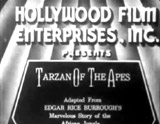
|
Tarzan of the Apes (1918) In this ten-reel silent film - the first screen version of Edgar Rice Burrough's jungle character, Tarzan at ten years old (Gordon Griffith as younger ape-boy Tarzan, Elmo Lincoln as adult) was almost nude for much of the first third of the film. He could be considered the first child actor to appear naked on screen. Then, he abruptly thought to himself: "Clothes! At the bottom of his little English heart survived a longing for them" - and adopted clothes to cover himself. The breasts and buttocks of African natives (called "negroes") in their camp were also briefly shown. |
 Young Tarzan Nude 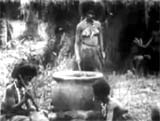 African Native Camp |
||||

|
Anders Als Die Andern (1919, Germ.) (aka Different From the Others) Director Richard Oswald's silent film (only half of which survived) was reportedly the first representation of male homosexuality (condemned as "the third sex") in a feature-length film, and the first screen depiction of a gay bar (with gay males and butch females). It was also notable as one of the first films (and maybe the first) to sympathetically portray homosexuality and defend it. The controversial film was banned by the Nazis (who despised and prohibited homosexuality) and all prints were ordered destroyed, although one incomplete print surfaced in the Ukraine. The film's themes were repeated in Victim (1961, UK), with Dirk Bogarde. The two ill-fated lovers were:
In one polemical scene, after a doctor/sexologist (Magnus Hirschfeld) vainly tried hypnosis to cure Korner, he then gave a defense of how homosexuality was acceptable:
The film had a tragic ending (suicide for Korner) when he was blackmailed (threats of exposure) for being homosexual, and he faced jail time for violating anti-homosexuality statutes and the social stigma of being outed. |
 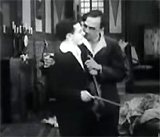 (l to r): Kurt, Paul Korner |
||||

|
Back to God's Country (1919, Can.) This exploitative silent era melodrama, by actress/writer/producer Nell Shipman (and directed by David Hartford), was probably the most successful Canadian silent feature film ever. It was taglined:
Due to its lurid advertising, it became the highest-grossing Canadian film made during the silent era. It featured the first full-frontal female nudity (although not clearly visible) of innocent, nature-loving Dolores LeBeau ("star" Nell Shipman) in the history of cinema. It occurred in a nude (skinny-dipping) swimming scene set in the Canadian backwoods mountains. When Dolores saw that she was being watched from afar (the man was identified as murderous criminal-fugitive Capt. Rydal (Wellington A. Playter) wearing the stolen uniform of a murdered Mountie), she jumped into the water, swam away, and crouched to hide behind a waterfall (all the time, she was covered by a flesh-covered leotard or bathing suit of some kind). Soon after, Rydal noted (in a title card): "I want to see more of that girl" - and he pursued her.
|
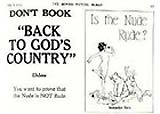 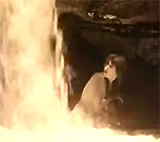 
Nude Swimming Scene |
||||

|
Male and Female (1919) Since this was a Cecil B. De Mille production (a silent adaptation of the play "The Admirable Crichton" by J. M. Barrie), it was bound to contain lurid or sensational scenes - typical of De Mille's brash and extravagant Biblical epics that always found an excuse to combine religion with sex. It was the biggest Paramount Pictures hit of its year, and notable for screen siren star Gloria Swanson, at the height of her popularity, displaying many elaborate and elegant costumes. This film, suggestively titled, featured a contrived plot that starred Gloria Swanson as snobby, pampered and spoiled socialite Lady Mary Lasenby (the female of the title) who engaged in a restrained and short extra-marital love affair with her respectful and dutiful butler (the male of the title), Crichton (Thomas Meighan). Their improper relationship occurred when they had become shipwrecked on a deserted South Seas tropical island where roles were inverted, and she learned lessons about class differences and the social hierarchy. Swanson was seen in a half-naked risque bathing scene in a sunken marble bathtub (filled with rosewater) in the film's beginning. Later in a fantasy and dreamy "King of Babylon" sequence, the leads were recast as a haughty monarch and feisty slave. Swanson was portrayed as a Christian slave girl in a leopard-print dress - including her sentencing by the king to descend into a Babylonian lion's den as "The Lion's Bride" (with "sacred lions of Ishtar") wearing a gown of pearls with a feathered headdress. |
 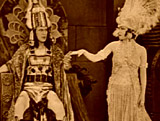 Starring Gloria Swanson 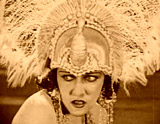 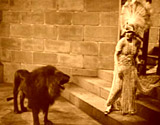 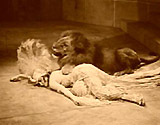
In Lion's Den |
||||